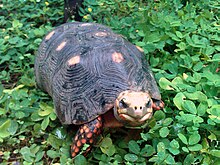Red-footed tortoise
| Red-footed tortoise | |
|---|---|
 |
|
| Scientific classification | |
| Kingdom: | Animalia |
| Phylum: | Chordata |
| Subphylum: | Vertebrata |
| Class: | Reptilia |
| Order: | Testudines |
| Suborder: | Cryptodira |
| Family: | Testudinidae |
| Genus: | Chelonoidis |
| Species: | C. carbonaria |
| Binomial name | |
|
Chelonoidis carbonaria (Spix, 1824) |
|
| Synonyms | |
The red-footed tortoise (Chelonoidis carbonaria) is a species of tortoises from northern South America. These medium-sized tortoises generally average 30 cm (12 in) as adults, but can reach over 40 cm (16 in). They have dark-colored, loaf-shaped carapaces (back shell) with a lighter patch in the middle of each scute (scales on the shell), and dark limbs with brightly colored scales that range from pale yellow to dark red. Recognized differences are seen between red-footed tortoises from different regions. They are closely related to the yellow-footed tortoise (C. denticulata) from the Amazon Basin. They are popularly kept as pets, and over-collection has caused them to be vulnerable to extinction.
Their natural habitat ranges from savannah to forest edges around the Amazon Basin. They are omnivorous with a diet based on a wide assortment of plants, mostly fruit when available, but also including grasses, flowers, fungi, carrion, and invertebrates. They do not brumate, but may aestivate in hot, dry weather.
Eggs, hatchlings, and young tortoises are food for many predators, but the main threats for adults are jaguars and humans. Population density ranges from locally common to very scarce due in part to habitat destruction and over-collection for food and the pet trade.
Red-footed tortoises have many common names: red-leg, red-legged, or red-foot tortoise (often without the hyphen) and the savanna tortoise, as well as local names, such as carumbe or karumbe, which means 'slow moving' (Brazil, Paraguay), wayapopi or morrocoy (Venezuela, Colombia), and variations of jabuti such as japuta and jabuti-piranga (Brazil, Argentina).
...
Wikipedia

